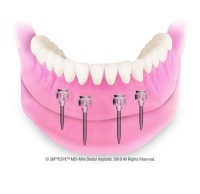Helpful Answers to Patient Questions from Your Dentist in Canton OH
Your dentist in Canton OH understands that dentistry can be a bit confusing! This is why the office of Dr. Hisrich has compiled a list of frequently asked questions for our patients, including information of a variety of topics like at-home dental care, teeth whitening, and other common inquiries. Do you have a question that isn’t listed below? Don’t hesitate to call our office at (330) 493-8400 and we’ll be happy to help!
The brand of the toothbrush is not as critical as the type of bristle and the size of the head. A soft toothbrush with a small head is recommended because medium and hard brushes tend to cause irritation and contribute to recession of the gums, and a small head allows you to get around each tooth more completely and is less likely to injure your gums. It's unnecessary to "scrub" the teeth as long as you are brushing at least twice a day and visiting your dentist at least twice a year for cleanings.
Generally, no. However, it's advisable to use a fluoride containing toothpaste to decrease the incidence of dental decay. We recommend our patients use what tastes good to them as long as it contains fluoride.
1.Firstly, make sure to use a soft bristled brush. Hard bristled brushes can wear down the enamel of your teeth.
2. Place your brush at a 45 degree angle to your gumline. Bristles should contact both the tooth surface and the gumline.
3. Use short back and forth strokes or tiny circular movements to brush your teeth. Each movement should be no bigger than the size of each tooth.
4. Make sure to use gentle strokes while brushing. Gentle strokes are effective in removing plaque, while too much pressure can wear down the enamel of your teeth.
5. Brush all surfaces of each tooth, including the outer, inner, and the chewing surfaces of the teeth.
6. Finally, don't cut your brushing short! Make sure to brush for at least 2 minutes.
1. Take 18" of floss and wind it around the middle finger of each hand .You can use these fingers to take up floss as it becomes dirty. Using your thumb and forefinger, pinch the floss leaving 1-2 inches in between for cleaning.
2. Gently move the floss up and down the spaces of your teeth. Never snap the floss down onto your gums, as it can cause damage.
3. As you move the floss down into the space between two teeth, slide it up and down against the surface of one tooth. Gently clean at the gumline as well.
4. Repeat this process for all of your teeth.
- gums that bleed while brushing
- red, swollen or tender gums
- gums that have pulled away from the teeth
- bad breath that doesn't go away
- pus between your teeth and gums
- loose teeth
- a change in the way your teeth fit together when you bite
- a change in the fit of partial dentures
In-office teeth whitening
In-office teeth whitening works by producing a significant color change in your teeth in short amount of time, usally within an hour. The procedure is done at the dentist's office applying a high-concentration peroxide gel on the teeth after they have been protected with a special shield.
Professionally Dispensed Take-Home Whitening Kits
These whitening kits are purchased from your doctor for use at home. The strength of the gel used in these kits is lower than that used for in-office bleaching, and thus the gel can be applied for longer periods of time. Usually the trays are worn a couple hours a day or overnight for a few days or weeks depending on the product.
Over the counter whitening
Over the counter teeth whitening kits are store-bought and use a lower concentration gel than both in-office bleachin and take-home kits purchased from your doctor. While they are less expensive, they typically are less effective than methods that can be performed by your dentist because of the low concentration gel. Additionally, over the counter trays are not custom fit for your teeth, which can result in irritation to your gums while wearing the trays.
Regardless of the cause of your bad breath, good oral hygiene and regular checkups to the dentist will help reduce it. Brushing and flossing will eliminate particles of food stuck between your teeth which emit odors. It will also help prevent or treat periodontal disease (gum disease), caused by plaque buildup on your teeth, which can lead to bad breath. Dentures should be properly cleaned and soaked overnight in antibacterial solution (unless otherwise advised by your dentist). Finally, make sure to brush your tongue regularly to eliminate any residue.
These are restorations to repair a severely broken tooth by covering all or most of the tooth after removing old fillings, fractured tooth structure, and all decay. The restoration material is made of gold, porcelain, composites, or even stainless steel. Dentists refer to all of these restorations as "crowns". However, patients often refer to the tooth-colored ones as "caps" and the gold or stainless steel ones as "crowns"
Both bridges and partial dentures replace missing teeth. A bridge is permanently attached to abutment teeth or, in some cases, implants. A partial denture is attached by clasps to the teeth and is easily removed by the patient. Patients are usually more satisfied with bridges than with partial dentures.
No. While most teeth that have had root canal treatments do need crowns to strengthen the teeth and to return the teeth to normal form and function, not every tooth needing a crown also needs to have a root canal.










